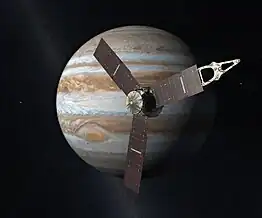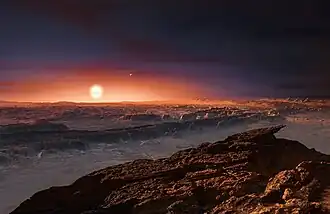Kepler-1638
Kepler-1638 is a G-type main-sequence star located about 5,000 light years away in the constellation of Cygnus.[1] One known exoplanet has been found orbiting the star: Kepler-1638b.[5][6][7][8] This planet may be a potentially habitable super-Earth. As of January 2021, Kepler-1638 is the farthest star with a known potentially habitable exoplanet.[9]
 Constellation where Kepler-1638 is located | |
| Observation data Epoch J2000.0 Equinox J2000.0 (ICRS) | |
|---|---|
| Constellation | Cygnus[1] |
| Right ascension | 19h 41m 55.76712s[2] |
| Declination | +48° 31′ 27.9998″[2] |
| Apparent magnitude (V) | 14.769±0.206[3] |
| Characteristics | |
| Evolutionary stage | main sequence star |
| Spectral type | G4V |
| Apparent magnitude (J) | 13.550±0.023[4] |
| Apparent magnitude (H) | 13.204±0.024[4] |
| Apparent magnitude (K) | 13.138±0.035[4] |
| Variable type | Planetary transit,[3] rotationally variable[4] |
| Astrometry | |
| Proper motion (μ) | RA: −5.092 mas/yr[2] Dec.: +5.839 mas/yr[2] |
| Parallax (π) | 0.6462 ± 0.0165 mas[2] |
| Distance | 5,000 ± 100 ly (1,550 ± 40 pc) |
| Details[3] | |
| Mass | 0.9700+0.0490 −0.0590 M☉ |
| Radius | 0.9500+0.1660 −0.0790 R☉ |
| Temperature | 5710.0+96.696 −111.431 K |
| Metallicity [Fe/H] | −0.0100+0.1410 −0.1880 dex |
| Age | 4.37+4.19 −2.59 Gyr |
| Other designations | |
| Database references | |
| SIMBAD | data |
Planetary system
| Companion (in order from star) |
Mass | Semimajor axis (AU) |
Orbital period (days) |
Eccentricity | Inclination | Radius |
|---|---|---|---|---|---|---|
| b | ~4.16 M🜨 | 0.745+0.021 −0.020 |
259.33683±0.01303 | — | 89.9954+0.0021 −0.0844° |
1.87+0.33 −0.22 R🜨 |
Kepler-1638 b is an exoplanet in orbit of its star, Kepler-1638, located in the constellation Cygnus. It was confirmed in 2016 as part of a study statistically validating hundreds of Kepler planets. Based on the parameters in the discovery paper, the planet is a super-Earth, with a radius of 1.87+0.33
−0.22 R🜨, and a predicted mass of 4.16 Earths. It has an orbit of 259.337±0.013 days in its system's habitable zone and orbits 0.745 AU from its star. It is the most distant known exoplanet that is considered potentially habitable.[3][8][5][6][7]
However, these parameters were estimated before the first measurement of the host star's parallax was published as part of Gaia DR2 in 2018. The Gaia parallax suggests a distance of about 1,548 parsecs (5,050 light-years),[2] much farther than the pre-Gaia estimate of about 764 parsecs (2,490 light-years).[10] This revised distance results in a significantly larger estimate of the radius of the star, and thus of the planet, with a 2018 study finding a planetary radius of 3.226+0.201
−0.315 R🜨. This would make the planet an ice giant like Neptune, and thus not potentially habitable in an Earth-like sense.[11][3]
References
- Staff (2 August 2008). "Finding the constellation which contains given sky coordinates". DJM.cc. Retrieved 16 July 2020.
- Vallenari, A.; et al. (Gaia collaboration) (2023). "Gaia Data Release 3. Summary of the content and survey properties". Astronomy and Astrophysics. 674: A1. arXiv:2208.00211. Bibcode:2023A&A...674A...1G. doi:10.1051/0004-6361/202243940. S2CID 244398875. Gaia DR3 record for this source at VizieR.
- "Kepler-1638". NASA Exoplanet Archive. Retrieved 2 February 2021.
- "Kepler-1638". SIMBAD. Centre de données astronomiques de Strasbourg. Retrieved 2 February 2021.
- Burgess, Matt (11 May 2016). "Nasa's Kepler telescope just found 1,284 exoplanets". Wired UK. ISSN 1357-0978. Retrieved 22 January 2021.
- "Exoplanet-catalog". Exoplanet Exploration: Planets Beyond our Solar System. Retrieved 22 January 2021.
- May 2016, Mike Wall 11 (11 May 2016). "1st Alien Earth Still Elusive Despite Huge Exoplanet Haul". Space.com. Retrieved 22 January 2021.
- Morton, Timothy D.; Bryson, Stephen T.; Coughlin, Jeffrey L.; Rowe, Jason F.; Ravichandran, Ganesh; et al. (May 2016). "False Positive Probabilities for all Kepler Objects of Interest: 1284 Newly Validated Planets and 428 Likely False Positives". The Astrophysical Journal. 822 (2): 86. arXiv:1605.02825. Bibcode:2016ApJ...822...86M. doi:10.3847/0004-637X/822/2/86. S2CID 20832201.
- "The Habitable Exoplanets Catalog - Planetary Habitability Laboratory @ UPR Arecibo". phl.upr.edu. Retrieved 21 January 2021.
- Torres, Guillermo; et al. (December 2017). "Validation of Small Kepler Transiting Planet Candidates in or near the Habitable Zone". The Astronomical Journal. 154 (6): 264. arXiv:1711.01267. Bibcode:2017AJ....154..264T. doi:10.3847/1538-3881/aa984b. S2CID 73678176.
- Berger, Travis A.; Huber, Daniel; Gaidos, Eric; van Saders, Jennifer L. (October 2018). "Revised Radii of Kepler Stars and Planets Using Gaia Data Release 2". The Astrophysical Journal. 866 (2): 99. arXiv:1805.00231. Bibcode:2018ApJ...866...99B. doi:10.3847/1538-4357/aada83.



